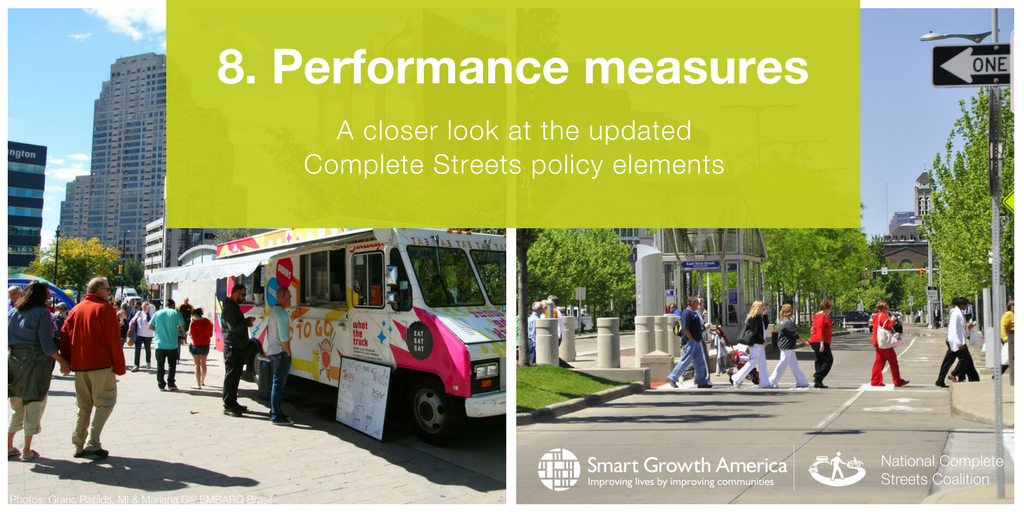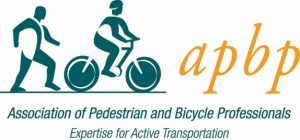
News
By Nimotalai Azeez, November 22, 2017

Performance measures exist to track and measure success in communities that have Complete Streets policies. The revised framework requires measures to expand beyond the usual metrics used such as the number of bike lanes. In Complete Streets policies, performance measures should address categories like access, economy, environment, safety, and health. They should also account for how implementation will impact communities of concern identified in the policy.
This post is part of Complete Streets month at Smart Growth America; we will be sharing a series of blog posts that cover and explain each of the 10 revised policy elements in some detail.
As we approach the end of November and Complete Streets month at Smart Growth America, it is only right we discuss performance measures in Complete Streets policies. This policy element is designed to measure the impacts and success of a policy after it is adopted. These should be in line with the policy goals and overall vision. We’ve revised this element by requiring jurisdictions to expand and establish performance measures under specific categories such as access, economy, environment, safety, and health.
“We can't improve what we don't know or track. The revised language on performance measure provides for increased opportunities not only to measure the work being done in Complete Streets but increased opportunities to identify areas for growth and improvement,” said Heidi Simon, Partnerships and Communications Director at America Walks.
Performance measures should pay particular attention to how Complete Streets implementation impacts the communities of concern identified in the policy. By embedding equity in performance measures, jurisdictions can evaluate whether disparities are being exacerbated or mitigated.
“The new language on equity works to make sure that Complete Streets policies are addressing the needs of all community members. As we see more cities, suburbs, and small-towns embrace Complete Streets, it is that much more important to make sure we are using this as an opportunity to include those that have been underrepresented in the past,” Simon added.
Examples of performance measures:
- Number of crashes and severity of injuries
- Injuries and fatalities for all modes
- Number of curb ramps Number of countdown signals
- Miles of accessible routes Sidewalk condition ratings
- Travel time in key corridors (point A to point B)
- Emergency vehicle response times
- Number of audible traffic signals
- Number of students who walk or bike to school
- Commercial vacancies in business improvement districts
- Number of mode users: walk, bike, transit
- Bike route connections to off-road trails
- Percentage of city that is within two miles of a ‘low stress’ bike route
- Number of bike share users
We also heard from another one of our Steering committee members on the revised policy element, Kate Whitfield an Associate Engineer/Planner at Alta Planning & Design and Board of Directors member for the Association of Pedestrian and Bicycle Professionals (APBP).
Expanding the framework for performance measures beyond the more typical metrics of miles of bikes lanes and number of people choosing to ride public transportation, municipalities will be better positioned to take their Complete Streets policies to the next level. We talk about monitoring and measuring performance but it is not always clear how. Now with consideration for health, safety, resilience etc., and the focus on accountability, a more well-rounded approach is emphasized and different variables defined. The act of specifying who will be responsible for reporting on progress and how often these indicators will be tracked is a positive step forward!
“Performance measures” is just one of 10 policy elements that will be featured this month. We’ve officially revised our policy grading rubric, known as the 10 Elements of a Complete Streets Policy. The Complete Streets movement has evolved since it began in 2004 to focus far more on implementation and equity, but the framework for grading the quality of policies hasn’t kept pace. For months, a group of national stakeholders, consisting of engineers, planners, researchers, and advocates, worked to revise the policy elements and truly raise the bar for what Complete Streets look like in practice. The entire revised framework will be available on our website on November 30, 2017.
Stay tuned for more Complete Streets updates during the month of November
- Have questions about the changes? Join us as we discuss how the new grading rubric will affect future policies during our webinar on December 1, 2017 at 1:00pm ET. The entire new grading rubric resource will be released on our website shortly before the webinar. Register for the webinar today >>
- We are now accepting nominations for the Best Complete Streets initiatives. Do you know of a project, initiative, event, person, task force, etc. that exemplifies Complete Streets? Fill out this brief nomination form >>
If you have any questions about the changes to the Complete Streets policy framework, please contact us! We’re happy to discuss further.
Special thanks to our featured Steering Committee members:
 America Walks is committed to mobilizing individuals, organizations and businesses to increase walking and walkability in America. Walkable communities help to promote physically, mentally and economically healthy neighborhoods, with studies consistently finding benefits to increasing walkability in all types and sizes of cities.
America Walks is committed to mobilizing individuals, organizations and businesses to increase walking and walkability in America. Walkable communities help to promote physically, mentally and economically healthy neighborhoods, with studies consistently finding benefits to increasing walkability in all types and sizes of cities.
 The mission of the Association of Pedestrian and Bicycle Professionals (APBP) is to grow the pedestrian and bicycle profession and its influence by facilitating the exchange of professional and technical knowledge, elevating practitioners’ skills and defining the field.
The mission of the Association of Pedestrian and Bicycle Professionals (APBP) is to grow the pedestrian and bicycle profession and its influence by facilitating the exchange of professional and technical knowledge, elevating practitioners’ skills and defining the field.
Related News

© 2026 Smart Growth America. All rights reserved
Site By3Lane Marketing









